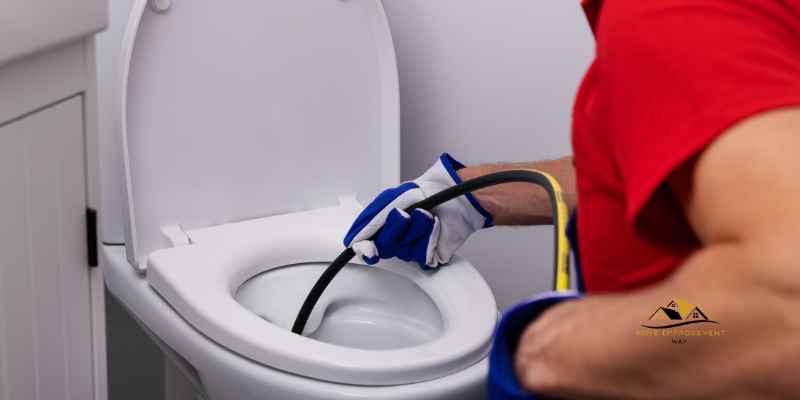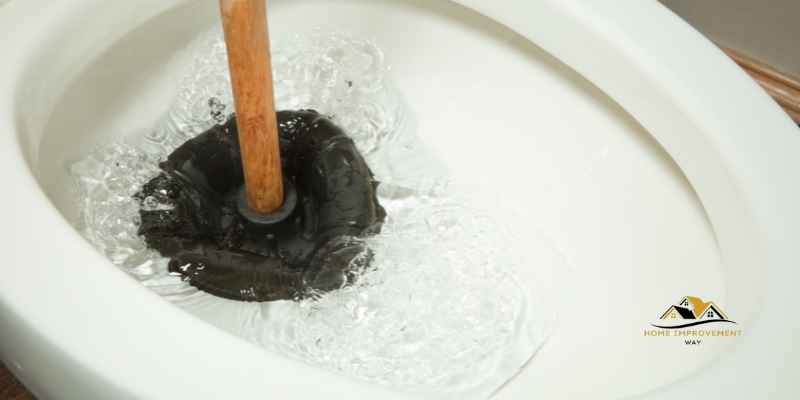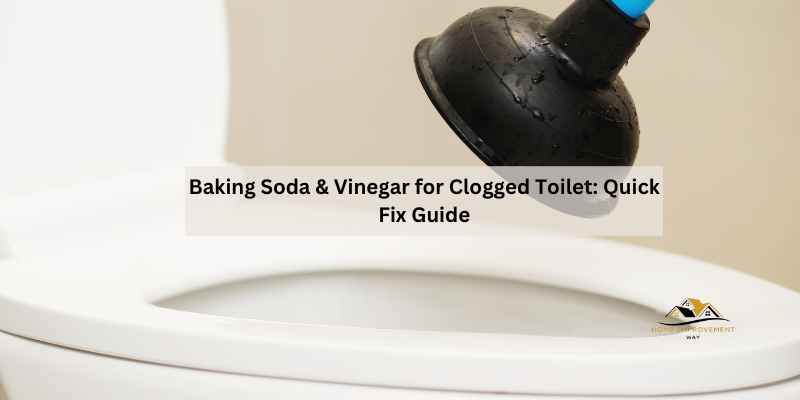Baking soda and vinegar can be used to unclog a toilet by pouring one cup of baking soda into the bowl followed by one cup of white vinegar, allowing the fizzy reaction to break up the clog before pouring in hot water and attempting to flush. While this method can be effective for simple blockages, persistent or severe clogs may require the assistance of a professional plumber.
It is important to use equal parts of vinegar and baking soda, and to allow the mixture to sit for at least an hour before attempting to flush. We will explore the benefits and limitations of using baking soda and vinegar to unclog a toilet, as well as alternative methods for addressing stubborn clogs.
Introduction To Natural Clog Removal
Clear a clogged toilet naturally with the fizzy reaction of baking soda and vinegar. Pour one cup of baking soda into the bowl, followed by a cup of white vinegar, and let the mixture sit for an hour before flushing.
This method is effective and environmentally friendly, requiring no frantic plunging.
Why Choose Baking Soda And Vinegar?
Baking soda and vinegar are a powerful duo for unclogging toilets naturally. The combination creates a fizzy reaction that can help break up stubborn clogs without harsh chemicals.
Chemical Reaction Explained
When mixed, baking soda and vinegar create bubbles that can dislodge blockages in your toilet pipes. This natural reaction is effective in breaking down organic matter causing the clog.
Before You Begin
Safety Precautions
- Wear gloves to protect your hands from bacteria.
- Avoid mixing vinegar with other chemicals.
- Ensure good ventilation in the bathroom.
Tools And Materials Needed
To unclog your toilet using baking soda and vinegar, you will need:
- 1 cup of baking soda
- 2 cups of white vinegar
- A kettle to boil water
- Gloves for protection
- A toilet brush
Step-by-step Unclogging Process
To unclog a toilet using baking soda and vinegar, start by pouring baking soda into the bowl followed by vinegar. Allow the mixture to fizz and break up the clog. Finish by pouring hot water and flushing to clear the blockage naturally and effectively.
Assessing The Severity Of The Clog
Before proceeding with the unclogging process, it’s important to assess the severity of the clog. If the water level in the toilet bowl is high and shows no sign of receding, the clog might be severe. In such cases, it’s advisable to refrain from flushing the toilet repeatedly, as it can lead to potential overflow. If the water level is not too high, it indicates a partial blockage, which can often be resolved with the baking soda and vinegar method.
Initial Baking Soda Application
Begin the unclogging process by pouring about a cup of baking soda directly into the toilet bowl. This step is crucial as baking soda has natural properties that can help break down organic matter causing the clog. Allow the baking soda to settle at the bottom of the bowl before moving on to the next step.
Adding Vinegar
After the baking soda has been added, slowly pour a cup of white vinegar into the toilet bowl. The combination of baking soda and vinegar will create a fizzy reaction, which helps to dislodge the clog. The effervescent action of the mixture can often be effective in breaking down the obstruction, allowing water to flow freely through the pipes.
Additional Steps For Stubborn Clogs
If you’ve tried the baking soda and vinegar method but your toilet clog persists, don’t worry. There are additional steps you can take to tackle stubborn clogs effectively.
Repeat The Process
If the initial attempt with baking soda and vinegar doesn’t fully clear the clog, don’t hesitate to repeat the process. Sometimes, stubborn clogs require multiple applications of the solution to break up the blockage.
Using Hot Water
Following the baking soda and vinegar treatment, consider using hot water to further dislodge the stubborn clog. Carefully pour a kettle of hot water into the toilet bowl and allow it to sit for a few minutes. The heat can help to soften and break apart the blockage, making it easier to flush away.
Common Mistakes To Avoid
When attempting to unclog a toilet using baking soda and vinegar, it’s important to be aware of common mistakes that can hinder the effectiveness of this natural remedy. By avoiding these pitfalls, you can increase the chances of successfully clearing the clog without causing any damage to your plumbing system.
Overusing Chemicals
One of the common mistakes people make when using baking soda and vinegar to unclog a toilet is overusing these chemicals. While the fizzy reaction can help break up minor clogs, excessive use of baking soda and vinegar can lead to a build-up of pressure in the toilet bowl, potentially causing it to overflow and create a mess.
Ignoring Plumbing Specifications
Another mistake to avoid is ignoring the plumbing specifications of your toilet. Different types of toilets have varying sensitivities to chemical reactions, and using baking soda and vinegar in toilets with certain materials or fragile components can lead to damage or corrosion.
Alternative Methods For Comparison

When dealing with a clogged toilet, there are various alternative methods to consider for comparison. These methods can be effective in clearing the clog and restoring the normal functioning of the toilet. Below, we’ll explore three popular alternative methods: Plunger Use, Commercial Cleaners, and Plumbing Snake.
Plunger Use
Using a plunger is a common and effective method for unclogging toilets. The suction and pressure created by the plunger can help dislodge the blockage and restore proper flow. To use a plunger, ensure a tight seal is formed around the drain opening and then push and pull in a pumping motion to create pressure and dislodge the clog.
Commercial Cleaners
Commercial cleaners specifically designed for unclogging toilets are readily available in the market. These products often contain powerful chemical agents that can dissolve and break down the clog. It is important to carefully follow the instructions provided with the cleaner and take necessary safety precautions when using these products.
Plumbing Snake
A plumbing snake, also known as a drain auger, is a tool used to manually remove clogs from drains and toilets. It consists of a long, flexible metal cable with a coiled auger or blade at one end. By inserting the snake into the toilet drain and maneuvering it carefully, it can reach and dislodge the clog, allowing for proper drainage.
Preventive Measures For Future Clogs
Prevent future clogs in your toilet by using a simple mixture of baking soda and vinegar. First, pour one cup of baking soda into the toilet bowl, followed by one cup of white vinegar. Let the mixture sit for an hour and then flush with hot water.
This natural remedy can help break up blockages without the need for a plunger.
Regularly maintaining your plumbing system can help prevent future toilet clogs. Here are some preventive measures you can take to avoid dealing with clogged toilets:
Regular Cleaning Recommendations
– Clean your toilet bowl weekly using a toilet brush and a mild cleaner.
– Avoid using harsh chemicals that can damage your pipes over time.
– Regularly inspect the flushing mechanism to ensure it’s working properly.
– Consider using enzymatic cleaners to break down organic matter in your pipes.
What Not To Flush
– Avoid flushing items such as paper towels, sanitary products, and cotton balls.
– Do not flush grease, oil, or food scraps down the toilet.
– Keep hair out of drains to prevent buildup in pipes.
– Dispose of items like dental floss and disposable wipes in the trash instead of flushing them.
By following these preventive measures and being mindful of what you flush down your toilet, you can reduce the likelihood of experiencing clogs in the future. Regular maintenance and proper disposal practices can help keep your plumbing system running smoothly.
When To Call A Professional
If your clogged toilet persists after using baking soda and vinegar, it may be time to seek professional help. Here are some signs that indicate it’s best to call in a plumber:
Recognizing Unsolvable Clogs At Home
- Toilet water is not draining or draining very slowly
- Repeated attempts with baking soda and vinegar have not resolved the clog
- Unpleasant odors or gurgling noises coming from the toilet
Finding A Reliable Plumber
- Ask for recommendations from friends or family
- Check online reviews and ratings of local plumbers
- Ensure the plumber is licensed and insured
Calling a professional plumber when needed can save you time and ensure the clog is properly addressed.

Frequently Asked Questions
Can You Unclog A Toilet With Baking Soda And Vinegar?
Yes, you can use baking soda and vinegar to unclog a toilet. First, pour one cup of baking soda into the bowl, then slowly pour a cup of white vinegar. The combination will create fizzing action that will hopefully break up the clog.
Lastly, pour a kettle full of hot water into the bowl and try to flush. If the clog is stubborn, it’s best to call a plumbing professional.
How Long Can I Leave Vinegar And Baking Soda In My Toilet?
You can leave vinegar and baking soda in your toilet for at least an hour.
What Can You Pour Down A Toilet To Unclog It?
You can pour baking soda and vinegar down a toilet to unclog it effectively. Start by adding one cup of baking soda, then pour in two cups of vinegar. Let it sit for an hour and then flush. If needed, repeat the process and let the solution sit overnight.
Will Vinegar Dissolve Toilet Paper?
Yes, vinegar can dissolve toilet paper when used in combination with baking soda for clog removal.
Conclusion
Using baking soda and vinegar to unclog a toilet can be effective. The fizzy reaction helps break up blockages, but for stubborn clogs, it’s wise to seek professional plumbing assistance. Remember to use equal parts of vinegar and baking soda for optimal results.


